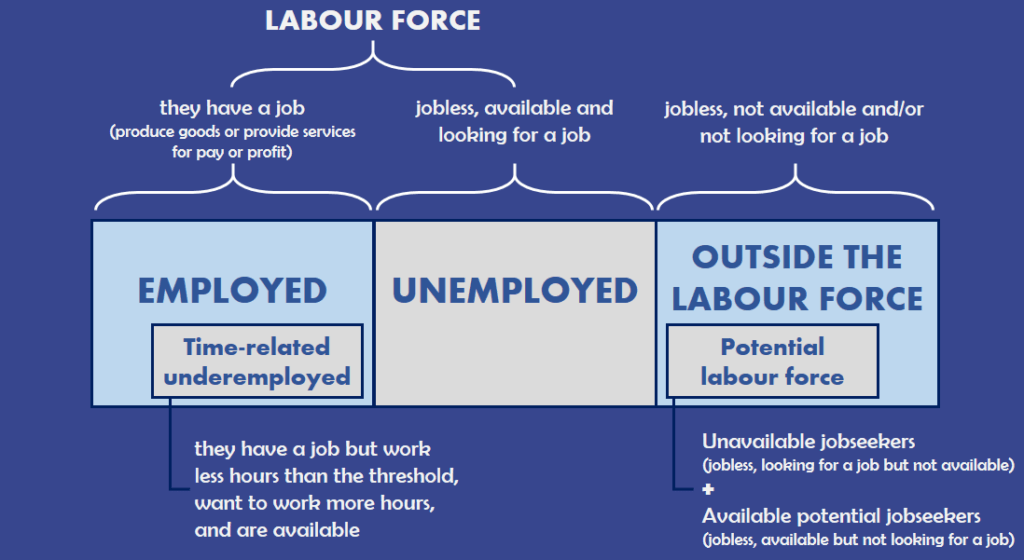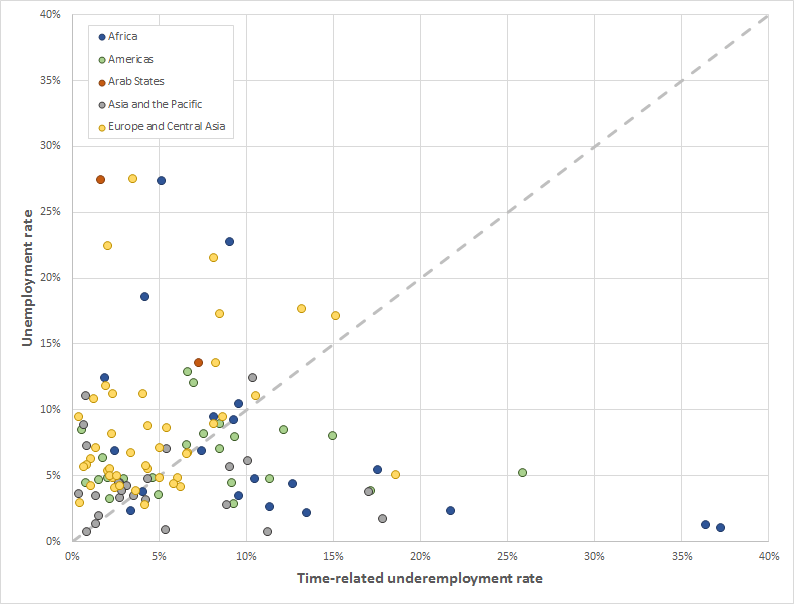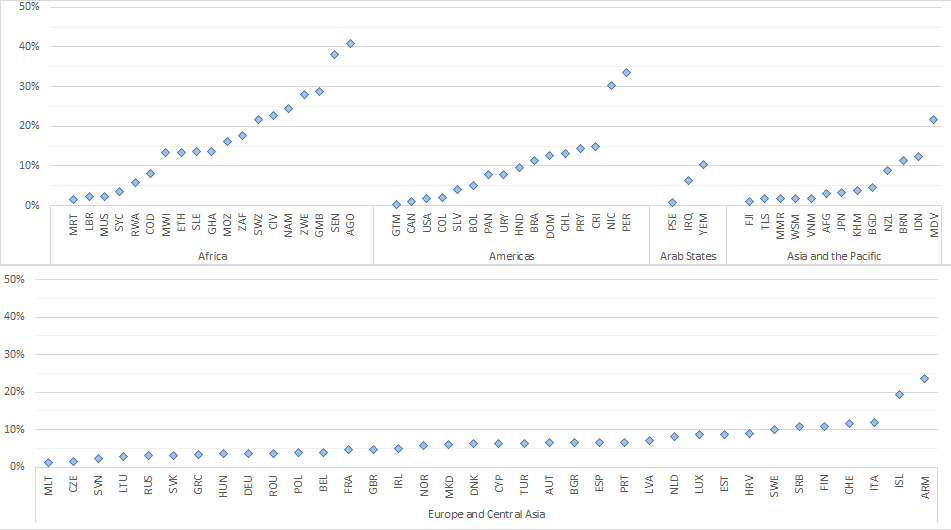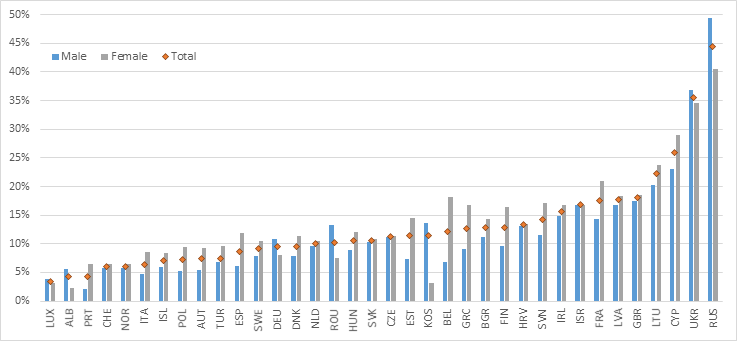The unemployment rate is the most widely cited labour market indicator by media and decision-makers around the world. But how useful is it really? Is it a good measure of the state of the labour market?
It conveys the percentage of persons in the labour force who do not have a job but are available and looking for one, where the labour force is the sum of employed persons and unemployed persons.

The unemployment rate provides a good depiction of the extent to which people who are ready to work are actually able to find and start a job. In other words, it expresses the labour market’s ability to satisfy people’s explicit demand for jobs, which is certainly useful and valuable information, but not enough to paint a full picture of the extent of labour underutilization and the overall state of the labour market.
In fact, the unemployment rate focuses on a very specific population (the unemployed) and says nothing about the situation of persons in employment or about persons outside the labour force.
Persons employed managed to escape unemployment, but are their jobs decent? Do their jobs provide for satisfactory working and living conditions? Having a job does not necessarily imply having a decent job, and persons in employment are not necessarily better off than the unemployed.
With regard to persons outside the labour force, do they still have some attachment to the labour force? Would they like to have a job eventually even if they are not actively looking or are not immediately available for one? Have they looked for jobs in the past but quit the job search out of discouragement?
These questions point to the limitations of examining the unemployment rate in isolation. While it is a useful and important measure, a comprehensive understanding of the labour market requires analysing additional indicators alongside the unemployment rate.

Labour underutilization among the employed: time-related underemployment rates
Comparing unemployment rates and time-related underemployment rates provides some insight into labour underutilization patterns. In 40 of the 114 countries with post-2009 data available, the time-related underemployment rate is higher than the unemployment rate, which means that in over a third of countries with data, labour underutilization is not as much a problem of joblessness as it is one of inadequate work of those in employment.

Among countries with available data, the time-related underemployment rate is larger than the unemployment rate in 65 per cent of African countries, 44 per cent of countries in Asia and the Pacific and 43 per cent of American countries, compared to only 14 per cent of countries in Europe and Central Asia. Underlying these regional differences, the level of economic development is clearly an important factor: in 82 per cent of low-income countries with available data, the time-related underemployment rate is larger than the unemployment rate. Thus, in the developing world, underemployment tends to be more widespread than outright unemployment. In fact, in the absence of sufficient unemployment benefits, employment office services, savings and/or family support, many individuals cannot afford to remain jobless and are compelled to take up any type of job, even if the working time on offer is less than desired.


Labour underutilization outside the labour force: the potential labour force
In many contexts, some persons outside the labour force do still have some attachment to the labour market and would eventually want to enter (or re-enter) the labour force. In order to better reflect this, the Nineteenth ICLS resolution introduced the concept of the potential labour force.
The potential labour force is made up of two groups of persons of working age not in employment or unemployment: (1) those who carried out activities to seek employment but were not currently available and would become available within a short subsequent period. This group is also known as the unavailable jobseekers; and (2) those who did not seek but wanted employment and were available, also known as the available potential jobseekers. Discouraged jobseekers represent a specific subset of the available potential jobseekers: those who did not seek employment for labour market-related reasons.
All these individuals who are not in employment or unemployment, despite being outside the labour force, do still have some attachment to it, either through their job search or their availability, which means that they are linked to the labour market. Even though they do not explicitly constitute the labour supply, they could potentially supply labour, thus representing another form of labour underutilization. Their labour underutilization is marked not only by their joblessness, but also by the circumstances keeping them from searching for a job or being available to take up a job. The unemployment rate disregards persons outside the labour force, failing to convey any type of information on their labour market situation, making it crucial to complement the analysis with other measures of labour underutilization. This is all the more important as in many countries the potential labour force represents a significant share of persons outside the labour force.

Composition of labour underutilization
In order to understand where the biggest challenges lie, it is necessary to look at the composition of the labour underutilization. This can be done by calculating the shares of unemployment, time-related underemployment and the potential labour force in overall labour underutilization. In this regard, the regional patterns show that unemployment is typically a form of labour underutilization for developed countries, whereas it is less common in developing countries. Developing countries are characterised by a lack of sufficient unemployment benefits, segmented labour markets, and informality, which leads to a concentration of labour underutilization among the employed and those outside the labour force, rather than in unemployment.
Where unemployment represents the largest share of labour underutilization, we can gather that labour underutilization is chiefly a problem of a lack of jobs for those actively searching for work. Time-related underemployment representing the biggest share of labour underutilization implies that labour underutilization is most prominent among the employed, with jobs having a shorter working time than what incumbents desire. The potential labour force comprising the largest share of labour underutilization highlights the problem of job search discouragement and unavailability to work due to care responsibilites.
The share of unemployment in total labour underutilization reflects the extent to which unemployment is indeed the main form of labour underutilization. In 87 per cent of the 70 countries with available data, the share of unemployment in labour underutilization is higher for men than for women, implying that women are more likely to be in other forms of labour underutilization than men. There could be various explanations for this: perhaps women tend to work fewer hours than they desire, their disproportionate care work could make them less likely to being available to take up a job, they may be prevented more often than men from job searching due to other responsibilities and commitments, or they may be discouraged to a greater extent in their job search, for instance due to gender-based labour market segregation whereby they have a smaller set of potential job opportunities vis-à-vis their male counterparts.

Qualitative labour underutilization: over-education
Time-related underemployment, unemployment and the potential labour force all comprise persons in a situation of labour underutilization, whereby they could be supplying labour (or additional labour) but are not. This refers to quantitative labour underutilization, that is, labour underutilization from the perspective of the amount of labour that could potentially be used and is not. Nevertheless, labour underutilization could also take a qualitative form, in terms of jobs not utilizing to the fullest the incumbents’ skills and abilities. Skill-related inadequate employment is also a form of labour underutilization, which can have important implications for the economy and the labour market.
Many possible types of skills mismatch may happen in the labour market, resulting from imbalances between skills offered by workers and those needed for jobs. The types of skills mismatch that constitute a form of labour underutilization are overeducation and overqualification, that is, the situation where the worker has a higher level of education or qualifications than the level required for the job.


If you found this interesting, take the time to read the full brief.
Author
-
Rosina Gammarano
Rosina is a Senior Labour Statistician in the Statistical Standards and Methods Unit of the ILO Department of Statistics. Passionate about addressing inequality and gender issues and using data to cast light on decent work deficits, she is a recurrent author of the ILOSTAT Blog and the Spotlight on Work Statistics. She has previous experience in the Data Production and Analysis Unit of the ILO Department of Statistics and the UN Resident Coordinator’s team in Mexico.
View all posts
